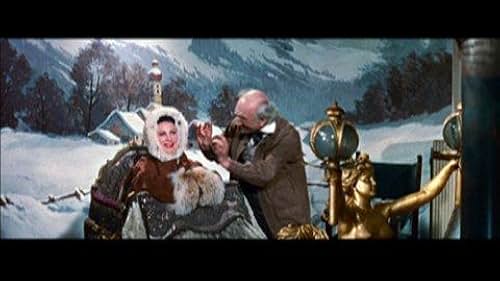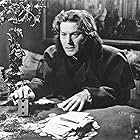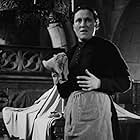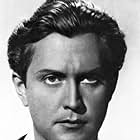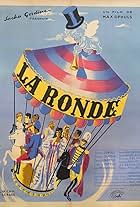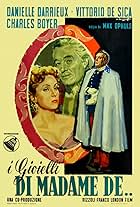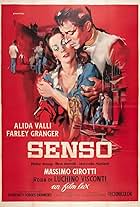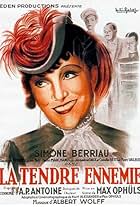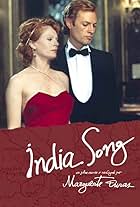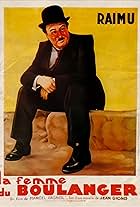VALUTAZIONE IMDb
7,2/10
6191
LA TUA VALUTAZIONE
Aggiungi una trama nella tua linguaWhen she is reduced to appearing in a circus, a notorious beauty thinks back on her past loves.When she is reduced to appearing in a circus, a notorious beauty thinks back on her past loves.When she is reduced to appearing in a circus, a notorious beauty thinks back on her past loves.
- Premi
- 1 candidatura
Héléna Manson
- Lieutenant James' Sister
- (as Helena Manson)
Carl Esmond
- Doctor
- (as Willy Eichberger)
Béatrice Arnac
- Circus Rider
- (non citato nei titoli originali)
Trama
Lo sapevi?
- QuizDirector Max Ophüls' final movie, and his only movie in color.
- BlooperWhen the Circus Master first tries to recruit Lola, he lists San Francisco as an important North American city, and includes Buffalo Bill in a list of major circus figures. This scene is set shortly before Montez left for Bavaria, so it must be late 1845 or early 1846. San Francisco was called Yerba Buena until 1847, and the name Buffalo Bill was first applied in the 1860s to Buffalo Bill Cody, who was born in 1846.
- Citazioni
Lola Montes: When a man is attractive, and you are terribly attractive, it's easy to yield, to hold on, to go almost too far. Now we are embarrassed by all those follies. We are starting to watch each other. We are trying to find each other again, to recognize ourselves, and our answers become questions.
- Versioni alternativeThe film was shot in three language versions: German, French and English. There was a fourth version, silent, used as a working copy; this was eventually found at the Luxembourg Cinematheque.
- ConnessioniEdited into Histoire(s) du cinéma: Fatale beauté (1994)
Recensione in evidenza
It is not entirely fair to recommend Lola Montes so highly, or admire it so, since even the version that screened recently at the Film Forum in NYC, purported to be the definitive restoration, is *still* a truncated version. The original director's cut that premiered in France in 1955, and then to immediate withdrawal after its "disaster" of a reception at 140 minutes, is no longer available. At the least, it's a saving grace that so much has been saved in this 115 minute cut, considering how many version there are and how they vary with the running time.
And, for Pete sake, if by some chance you can see it on the big-screen (it's soon to leave the Film Forum for its *second* run following the re-release last October and its re-premiere at the NYFF), do so. The filmmaker, Max Ophuls, in what was his unintentional swan song- he died at 55- shot the hell out of this picture, with director of photography Christian Matras taking the 2:35:1 frame with new Eastmancolor by the horns and shaking it for all it could be worth within the context of a "vibrant" 19th century costume melodrama bio-pic. The colors all jump off so splendidly, with such a force that compels one to not have too long of a blink, as to do so would be to miss on little surprises, little things that Ophuls uses in his frame which he careens and swivels and moves around with the freedom of a curious, pleasantly intoxicated fowl. It's one of the first masterpieces of the widescreen color film.
But it's not just a great film in technical terms. That would be too easy perhaps for Ophuls, who uses this backdrop of the sweeping and sensational to pierce through other deeper things going on with the characters. In Lola Montes his character is someone who re-lives what has happened in her relatively short life (relatively since she's not really "old" in the sense of being tucked away from the public's gaze) as a main attraction in a French circus.
She's an object first and person second in this context, which as one can imagine bustles and throbs with excitement and fun as only something of a cousin to Fellini could be. And yet as a person she's had quite a journey to where she's at: from aristocratic daughter given away to a marriage she has to run away from (unfaithful husband, figures with a wife who is about as beautiful a being as could be in the immediate vicinity), then becomes a ballerina (her childhood dream), and then... well, a topic of gossip and scandal, such as romancing a conductor, all ending in Bavaria with her hopes of possibly settling down squandered for good. Hence the circus gig.
It's a story that's given that same kaleidoscopic view as in Citizen Kane, but this time with the twist that the protagonist isn't given the sort of "luxury" of already being dead as the story of a life is sifted through and given a LARGER-than-LIFE context. Lola's story is a spectacle, sometimes farce, sometimes legend, sometimes one of those too-much-to-believe sagas that keeps those glued to their seats while Lola also entertains with trapeze work! And yet under the blue lights, under the costume changes and other mock-ups and even the Q&A sessions that the ringmaster holds with the audience and Lola, the soul of this woman is about as "there" as a near-empty gas tank. She may still be alive, but it's a kind of limbo that would be too insane if it weren't true and played out to full spectacle and extravaganza.
As said, this is a work of true technical mastery, and there's one amazing camera move or one amazing little direction (I just smiled ear to ear seeing in the opening how the circus performers rolled out, and it stayed for a solid five minutes). But, too, Ophuls has an engaging, wonderful actress on top of having a complete knockout visually: Martine Carol, who I'm not sure I've seen outside of this film, pulls out a performance that wavers between weepy, flustered, driven, elegant, tortured, calm and hiding back hysteria. It's half diva and half substantially undermined human soul, and she pulls it off like it's the performance of a life. Good marks also go to Peter Ustinov as the Ringmaster, chugging along through a script that he knows almost too well (we get very amusing asides with one of the "little" people in the red costumes trying to get their change back from him mid-act), and the actor who played the Bavarian king. In Ophuls hands, they're not just other pieces of the set, but actors who work so diligently to make this all one cohesive piece.
And, really, that's what makes Lola Montes ultimately so remarkable. Ophuls has moments of melodrama, maybe so much so that one will have to really love costume-period-melodrama flicks to really appreciate it (I actually don't usually, this is an exception), and at the same time they all work as part of this story about what lies behind the pomp and circumstance. You can get lost from time to time in this movie, and it's thrilling to get wrapped up in it. And as well as an artistic achievement of considerable proportions, it's a really fun movie to boot.
And, for Pete sake, if by some chance you can see it on the big-screen (it's soon to leave the Film Forum for its *second* run following the re-release last October and its re-premiere at the NYFF), do so. The filmmaker, Max Ophuls, in what was his unintentional swan song- he died at 55- shot the hell out of this picture, with director of photography Christian Matras taking the 2:35:1 frame with new Eastmancolor by the horns and shaking it for all it could be worth within the context of a "vibrant" 19th century costume melodrama bio-pic. The colors all jump off so splendidly, with such a force that compels one to not have too long of a blink, as to do so would be to miss on little surprises, little things that Ophuls uses in his frame which he careens and swivels and moves around with the freedom of a curious, pleasantly intoxicated fowl. It's one of the first masterpieces of the widescreen color film.
But it's not just a great film in technical terms. That would be too easy perhaps for Ophuls, who uses this backdrop of the sweeping and sensational to pierce through other deeper things going on with the characters. In Lola Montes his character is someone who re-lives what has happened in her relatively short life (relatively since she's not really "old" in the sense of being tucked away from the public's gaze) as a main attraction in a French circus.
She's an object first and person second in this context, which as one can imagine bustles and throbs with excitement and fun as only something of a cousin to Fellini could be. And yet as a person she's had quite a journey to where she's at: from aristocratic daughter given away to a marriage she has to run away from (unfaithful husband, figures with a wife who is about as beautiful a being as could be in the immediate vicinity), then becomes a ballerina (her childhood dream), and then... well, a topic of gossip and scandal, such as romancing a conductor, all ending in Bavaria with her hopes of possibly settling down squandered for good. Hence the circus gig.
It's a story that's given that same kaleidoscopic view as in Citizen Kane, but this time with the twist that the protagonist isn't given the sort of "luxury" of already being dead as the story of a life is sifted through and given a LARGER-than-LIFE context. Lola's story is a spectacle, sometimes farce, sometimes legend, sometimes one of those too-much-to-believe sagas that keeps those glued to their seats while Lola also entertains with trapeze work! And yet under the blue lights, under the costume changes and other mock-ups and even the Q&A sessions that the ringmaster holds with the audience and Lola, the soul of this woman is about as "there" as a near-empty gas tank. She may still be alive, but it's a kind of limbo that would be too insane if it weren't true and played out to full spectacle and extravaganza.
As said, this is a work of true technical mastery, and there's one amazing camera move or one amazing little direction (I just smiled ear to ear seeing in the opening how the circus performers rolled out, and it stayed for a solid five minutes). But, too, Ophuls has an engaging, wonderful actress on top of having a complete knockout visually: Martine Carol, who I'm not sure I've seen outside of this film, pulls out a performance that wavers between weepy, flustered, driven, elegant, tortured, calm and hiding back hysteria. It's half diva and half substantially undermined human soul, and she pulls it off like it's the performance of a life. Good marks also go to Peter Ustinov as the Ringmaster, chugging along through a script that he knows almost too well (we get very amusing asides with one of the "little" people in the red costumes trying to get their change back from him mid-act), and the actor who played the Bavarian king. In Ophuls hands, they're not just other pieces of the set, but actors who work so diligently to make this all one cohesive piece.
And, really, that's what makes Lola Montes ultimately so remarkable. Ophuls has moments of melodrama, maybe so much so that one will have to really love costume-period-melodrama flicks to really appreciate it (I actually don't usually, this is an exception), and at the same time they all work as part of this story about what lies behind the pomp and circumstance. You can get lost from time to time in this movie, and it's thrilling to get wrapped up in it. And as well as an artistic achievement of considerable proportions, it's a really fun movie to boot.
- Quinoa1984
- 26 feb 2009
- Permalink
I più visti
Accedi per valutare e creare un elenco di titoli salvati per ottenere consigli personalizzati
- How long is Lola Montès?Powered by Alexa
Dettagli
- Data di uscita
- Paesi di origine
- Siti ufficiali
- Lingue
- Celebre anche come
- The Sins of Lola Montes
- Luoghi delle riprese
- Aziende produttrici
- Vedi altri crediti dell’azienda su IMDbPro
Botteghino
- Budget
- 650.000.000 FRF (previsto)
- Lordo Stati Uniti e Canada
- 120.306 USD
- Fine settimana di apertura Stati Uniti e Canada
- 12.569 USD
- 12 ott 2008
- Lordo in tutto il mondo
- 303.175 USD
- Tempo di esecuzione1 ora 56 minuti
- Proporzioni
- 2.55 : 1
Contribuisci a questa pagina
Suggerisci una modifica o aggiungi i contenuti mancanti

Divario superiore
By what name was Lola Montès (1955) officially released in India in English?
Rispondi
